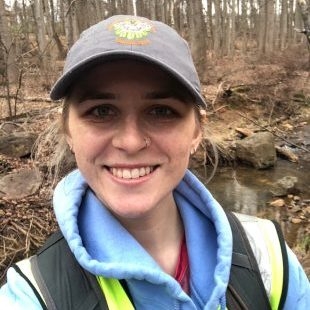Congrats to IGC Fellows Receiving ISWG Graduate Research Grants
January 24, 2024

The GCC’s Invasive Species Working Group (ISWG), offered its inaugural Graduate Research Grant program this past October. This initiative, tailored to support graduate students engaged in the realms of invasive species policy, prevention, ecology, technology development, and more, has successfully awarded over $18,000 to seven outstanding projects. Four of these projects feature the involvement of graduate students in the Interfaces of Global Change (IGC) Interdisciplinary Graduate Education Program (IGEP).
Congratulations to our accomplished IGC fellows who have secured grant funding! Learn more about their research projects below, and be sure to check out the latest ISWG newsletter to learn more about all seven of the projects.
Abir Jain, Fish and Wildlife Conservation
Assessing the functional traits and seed dispersal networks of fleshy-fruiting invasive species in Virginia’s Appalachian forests
Abir's project, building on a GCC Seed Grant, aims to investigate the primary seed dispersers of common invasive fruiting plants in the Appalachian forests by installing camera traps, and identifying potential interactions that might interfere with the existing seed dispersal patterns of native plant species. The project includes a detailed network analysis to explore the extent to which invasive/introduced fruits depend on generalist frugivores for their seed dispersal. Additionally, the study will assess the specific role of invasive dispersers, such as European starlings, in the seed dispersal of both native and invasive plants, as well as the contribution of migrant birds in the dispersal of introduced species. This project will also examine some chemical traits of invasive fruits that might be helping them attract more dispersers. This research holds the potential to uncover critical insights into the dynamics of seed dispersal networks in the Appalachian forests, shedding light on the impact of invasive species on the ecological balance.
Grace O'Malley, Biological Sciences
Acoustic monitoring and fine-scale error rates of detection for an invasive and native anuran in the southwestern US
Grace's project aims to evaluate the effectiveness of bioacoustic monitoring, particularly focusing on the calls of L. catesbeianus (the invasive American bullfrog) and H. wrightorum's (the native American Treefrog). The project's key objectives include examining the relationship between site characteristics and the error rate of detection for the calls of these two species, as well as determining if there are differences in false positive and false negative error rates of detection between the species.
Understanding the efficacy and potential pitfalls of bioacoustic monitoring approaches is crucial for advancing invasive species monitoring efforts, especially across large spatial scales. By disseminating results and lessons learned from this large-scale project, Grace aims to assist agencies and other groups in making passive acoustic monitoring at large scales an achievable and valuable step in the management of invasive species.
Gabrielle Ripa, Plant and Environmental Sciences
Soil nutrient availability as a predictor of invasive plant establishment on restored streams
Gabrielle’s project is drawing from her ongoing work on urban stream restoration projects in the Chesapeake Bay Watershed. The project centers on examining how soil nutrients influence the establishment of invasive plants. Preliminary data suggests that, at best, stream restoration efforts are not discouraging invasion, and at worst, they may be promoting it. There's an observed trend towards a greater proportion of cover by non-native species and reduced cover of native species on restored streams. Gabrielle's hypothesis revolves around the idea that streams with nutrient-rich soil become more susceptible to invasion due to the heightened availability of resources. Gabrielle plans to focus on understanding the influence of soil nutrient availability on invasibility, with the hope of offering practical recommendations to stream restoration practitioners on mitigating invasive plant establishment in restoration projects.
Terrestrial and aquatic macroinvertebrate community responses to invasion and stream restoration
Gabrielle is also a co-PI on a project with Matt Sharpe a graduate student in the Entomology Department. This project aims to investigate the impact of invasive plants on frog populations through changes in arthropod communities. Building on existing research about the effects of stream restoration and non-native plants on frogs, the project will use passive acoustic monitoring data from restored and unrestored streams. Comparing frog communities and calling density with terrestrial and aquatic macroinvertebrate abundances, the study seeks to understand how invasive plants and stream restoration affect the food sources of frogs, providing insights into potential indirect effects of invasive species on frog populations.







